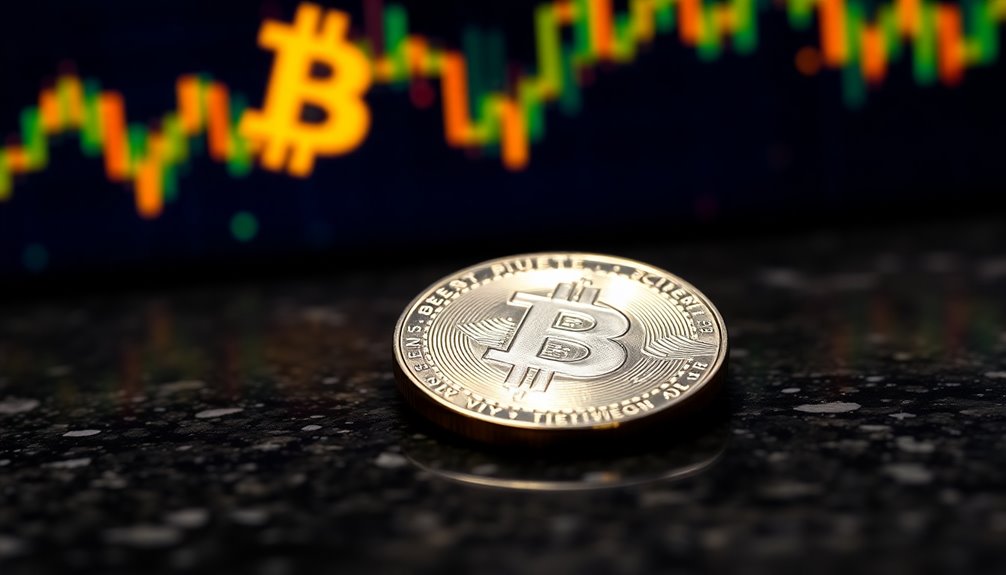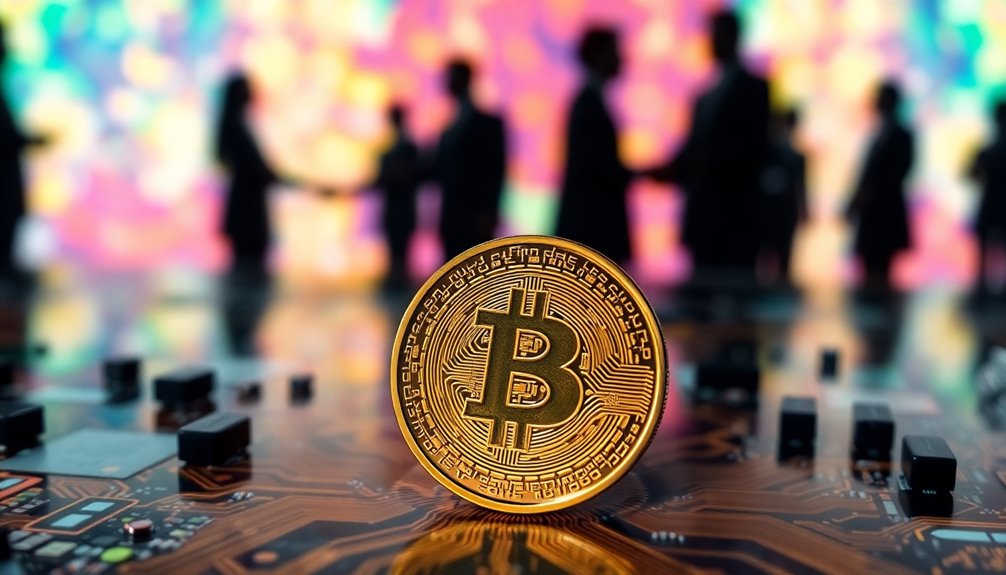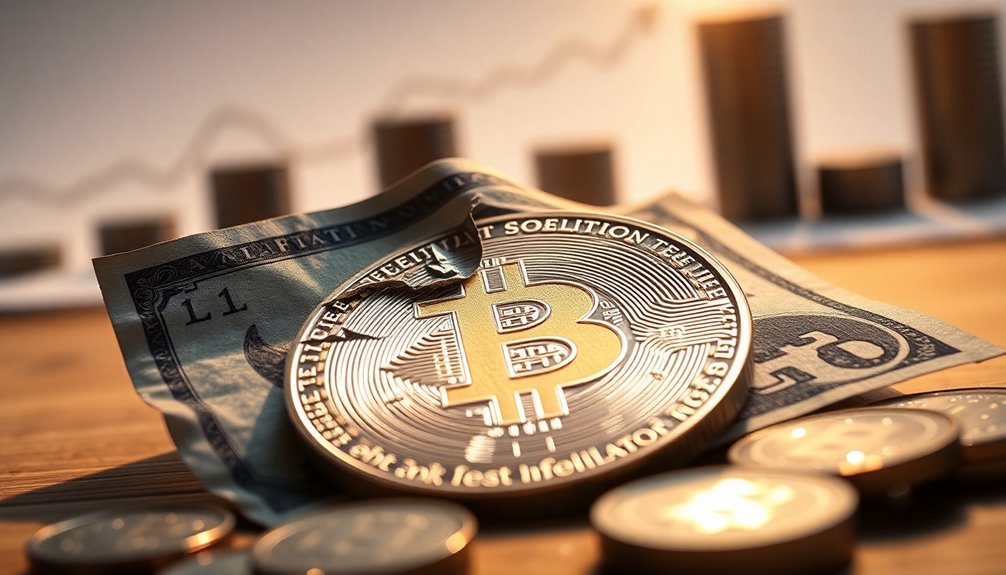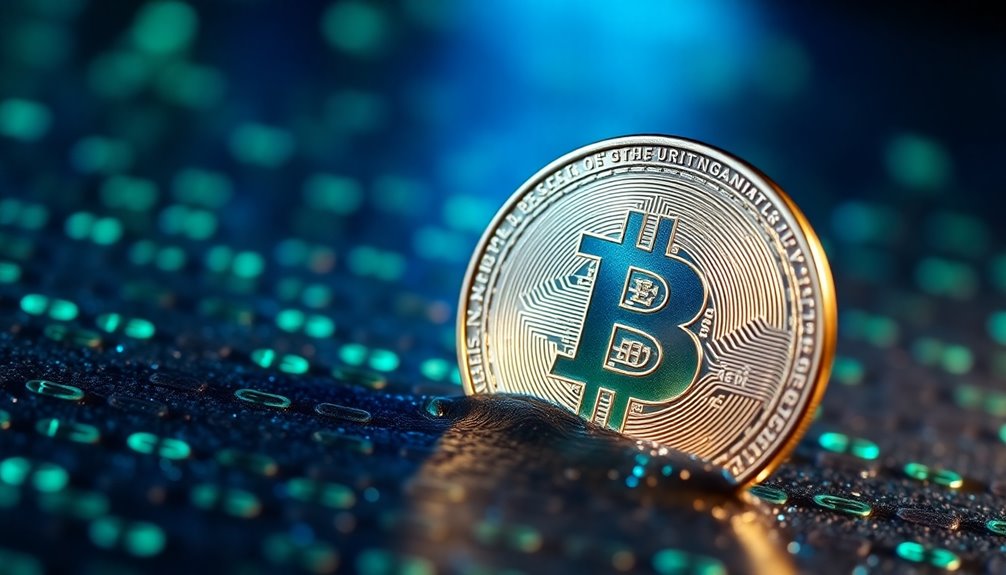Fiat currency in crypto is government-issued money that's vital for connecting traditional finance with the digital asset world. Think of it as the bridge that allows you to trade cryptocurrencies on platforms or exchanges. Its value comes from trust in the issuing government and fluctuates based on supply and demand. Stablecoins, pegged to fiat currencies, keep value steady and saw a transaction volume of $5.7 trillion recently. This blend helps you engage more easily in decentralized finance and other crypto activities. Curious about how these concepts interact in more detail? There's much more to explore!
Key Takeaways
- Fiat currency is government-issued money, not backed by physical commodities, used in crypto for transactions and value exchange.
- It serves as a bridge between traditional finance and digital assets on centralized exchanges and DeFi platforms.
- Fiat-referenced cryptoassets, like stablecoins, maintain value stability by being pegged to fiat currencies.
- Central banks control fiat supply, impacting its value and stability, which is essential in the crypto ecosystem.
- Growing adoption of fiat and stablecoins is expected as digital currency markets evolve and integrate with traditional finance.
Fiat Currency Fundamentals

Although it might seem straightforward, understanding fiat currency is essential for grasping its role in the economy.
Fiat currency is money issued by a government and gains its value from that backing and legal recognition, rather than being tied to a physical commodity like gold or silver. Its value fluctuates based on supply and demand in the market.
In healthy economies, annual inflation rates hover around 2%, influenced by government actions and economic events. Central banks regulate supply and stabilize these currencies, but excessive printing can lead to hyperinflation. This significant control allows governments to manipulate monetary policies to respond to economic challenges.
Fiat currency's divisibility and universal acceptance make it convenient for everyday transactions, although it may face processing delays within the legacy financial system.
Understanding Fiat's Role

Fiat currency plays a significant role in the crypto ecosystem, acting as a bridge between traditional finance and the world of digital assets. It serves as a medium of exchange on centralized exchanges and DeFi platforms, enabling seamless transactions. You'll find that fiat-referenced cryptoassets act as a store of value and facilitate efficient liquidity management, thanks to faster blockchain transactions. These assets also support smart contracts, making automatic payments possible based on specific conditions. Additionally, they enable micropayments, which are crucial for machine-to-machine transactions. Unlike traditional fiat, these cryptoassets are purely digital and often operate under different regulatory frameworks, increasing their versatility within the crypto landscape while promoting financial inclusion and improving cross-border payment efficiency. The global market value of fiat-referenced cryptoassets surged to US$161 billion from 2020 to mid-2022, reflecting their growing importance in the financial landscape.
Currency Value Determined by Trust

Trust is the cornerstone of fiat currency value, fundamentally relying on the confidence individuals have in the issuing institutions, typically central banks.
You see, central banks uphold this trust through sound monetary policies and oversight. Without proper fiscal backing, trust can erode, leading to doubts about the currency's stability. While central banks can face negative equity, there's a limit; beyond that, trust dissipates. Moreover, the social convention that fiat money will be accepted as a medium of exchange is crucial. You rely on the understanding that others will honor its value.
Historical cases, like the Bank of Amsterdam, illustrate how quickly trust can vanish if institutions fail. In fact, trust in monetary and fiscal policies is essential for societal wellbeing, fostering long-term commitment to economic stability.
Ultimately, maintaining transparency and stability is vital for ongoing public confidence in fiat currency.
Pros and Cons Summary

When evaluating the pros and cons of fiat currency, it's essential to recognize both its advantages and drawbacks in practical use.
On the plus side, fiat currency offers liquidity, making transactions straightforward, and a clear regulatory framework ensures transparency. Governments act as a safety net, managing inflation and protecting consumers during downturns, which is crucial given that central banks control the supply of fiat currency.
However, there are notable downsides. The potential for hyperinflation looms large, and counterfeiting remains a risk. Transactions can face delays, especially cross-border ones, and may incur high fees. Additionally, the lack of privacy in fiat transactions can be concerning.
Weighing these factors helps you understand fiat's role in the financial landscape, especially in the context of cryptocurrency.
Fiat vs. Cryptocurrency Value

Fiat currency relies on government and economic stability, with its worth tied to public trust in the issuing authority. Central banks regulate the money supply to maintain price stability, but excessive printing can lead to devaluation. In contrast, cryptocurrencies derive their value from market forces like supply and demand, resulting in high volatility. Prices can swing dramatically due to market sentiment and speculation. This volatility is further exacerbated by the fact that cryptocurrencies operate within a decentralized system, making them susceptible to rapid changes in investor sentiment and external factors. While stablecoins attempt to mitigate this volatility, cryptocurrencies remain inherently riskier.
Inflation and Currency Devaluation

Inflation poses a significant threat to the stability of fiat currency, eroding purchasing power and altering economic dynamics. When you see prices rising, it often means the money supply's growing faster than the economy's output.
In healthy economies, annual inflation rates hover around 2%, but unexpected events, like the COVID-19 crisis, can spike those numbers. High inflation leads to currency devaluation, making imports pricier and diminishing what you can buy. Historically, gold has performed well during inflationary periods, serving as a hedge against devaluation.
This slowdown in growth can deter investments and reduce confidence in your currency. To safeguard against devaluation, consider investing in tangible assets like gold, diversifying your investments, or using financial instruments like futures to mitigate risks. Central banks play a crucial role in stabilizing currency value through effective monetary policy.
Central bank policies also play a crucial role in stabilizing currency value.
Digital Fiat Adoption Rates

In recent years, the adoption of digital fiat has surged, reflecting a significant shift in how people engage with currency. Countries like Vietnam and those in Latin America and Southeast Asia are leading the way, showing higher adoption rates of both cryptocurrencies and their digital fiat equivalents. Notably, emerging markets dominate the Global Crypto Adoption Index, highlighting the unique financial needs that drive this trend.
In contrast, developed nations tend to stick with traditional fiat currencies. This adoption varies greatly due to regional regulatory attitudes and the accessibility of financial services. Digital fiat integrates seamlessly into existing systems, using technologies like blockchain and digital wallets. As companies develop solutions like debit cards that convert crypto to fiat, the landscape becomes more user-friendly, paving the way for broader acceptance and use in everyday transactions.
Utilize Stablecoins for Transactions

As you explore the world of digital transactions, stablecoins can offer a reliable alternative to traditional currencies. These cryptocurrencies, like USDT and USDC, are pegged to fiat currencies such as the US Dollar, maintaining a 1:1 value ratio. Total transaction volume reached an impressive $5.7 trillion, highlighting the growing adoption of stablecoins in the market.
When you exchange fiat for stablecoins, issuers hold the equivalent amount in secure bank accounts, ensuring transparency through regular audits. Operating 24/7, stablecoins facilitate seamless transactions, often at lower costs compared to traditional methods. Their use cases span decentralized finance (DeFi) and beyond, making them essential for liquidity in the crypto market.
Frequently Asked Questions
How Does Fiat Currency Affect Cryptocurrency Regulations?
Fiat currency significantly impacts cryptocurrency regulations.
As you navigate the financial landscape, you'll notice that governments prioritize regulating fiat to ensure stability and consumer protection. This creates a framework that cryptocurrencies often struggle to fit within.
Regulatory bodies focus on addressing issues like money laundering and market integrity, making it harder for cryptocurrencies to gain acceptance.
As a result, the evolving relationship between fiat and crypto shapes the regulatory environment you interact with.
Can Fiat Currencies Be Converted Directly to Cryptocurrencies?
Did you know that in 2021, over $3 trillion in fiat currency was converted to cryptocurrencies?
Yes, you can convert fiat currencies directly to cryptocurrencies through various exchanges. Just choose a reliable platform, create an account, and deposit your fiat via bank transfer or credit card.
Once you've done that, you can purchase your desired crypto easily. Make sure to check the fees and transaction times to ensure a smooth experience!
What Are the Historical Examples of Fiat Currency Failures?
You'll find numerous historical examples of fiat currency failures that illustrate the fragility of such systems.
The hyperinflation in Weimar Germany and Zimbabwe left currencies nearly worthless, while France's Assignat lost 99% of its value in just five years.
Similarly, the bolivar in Venezuela suffered severe devaluation.
These instances show how overissuance, loss of public trust, and economic instability can lead to devastating consequences for fiat currencies.
Are There Any Benefits to Using Fiat Over Cryptocurrency?
Imagine using a golden coin to pay for your morning coffee—fiat money offers that level of simplicity.
You'll find fiat currency's widespread acceptance, stability, and regulatory oversight make it a reliable choice for everyday transactions.
Unlike cryptocurrencies, it's integrated with banking systems, ensuring quick, familiar payments without the learning curve.
Plus, you're protected by consumer laws, which adds an extra layer of security to your financial dealings.
How Do Central Banks Control Fiat Currency Supply?
Central banks control the supply of fiat currency by carefully managing its issuance and distribution. They print banknotes and mint coins, distributing them through the banking system.
To avoid inflation, they adjust the money supply using tools like open market operations, interest rates, and reserve requirements. By buying or selling government securities and altering interest rates, central banks influence lending, borrowing, and overall economic stability, ensuring that the economy remains balanced.
Conclusion
In the ever-shifting landscape of finance, understanding fiat currency's role in the crypto world is like navigating a bustling marketplace. You've seen how trust shapes value and how inflation can erode purchasing power. As digital currencies rise, stablecoins offer a bridge, blending the old with the new. Embracing these changes, you can confidently explore this vibrant ecosystem, ensuring your financial journey remains steady, even as the tides of currency ebb and flow around you.









